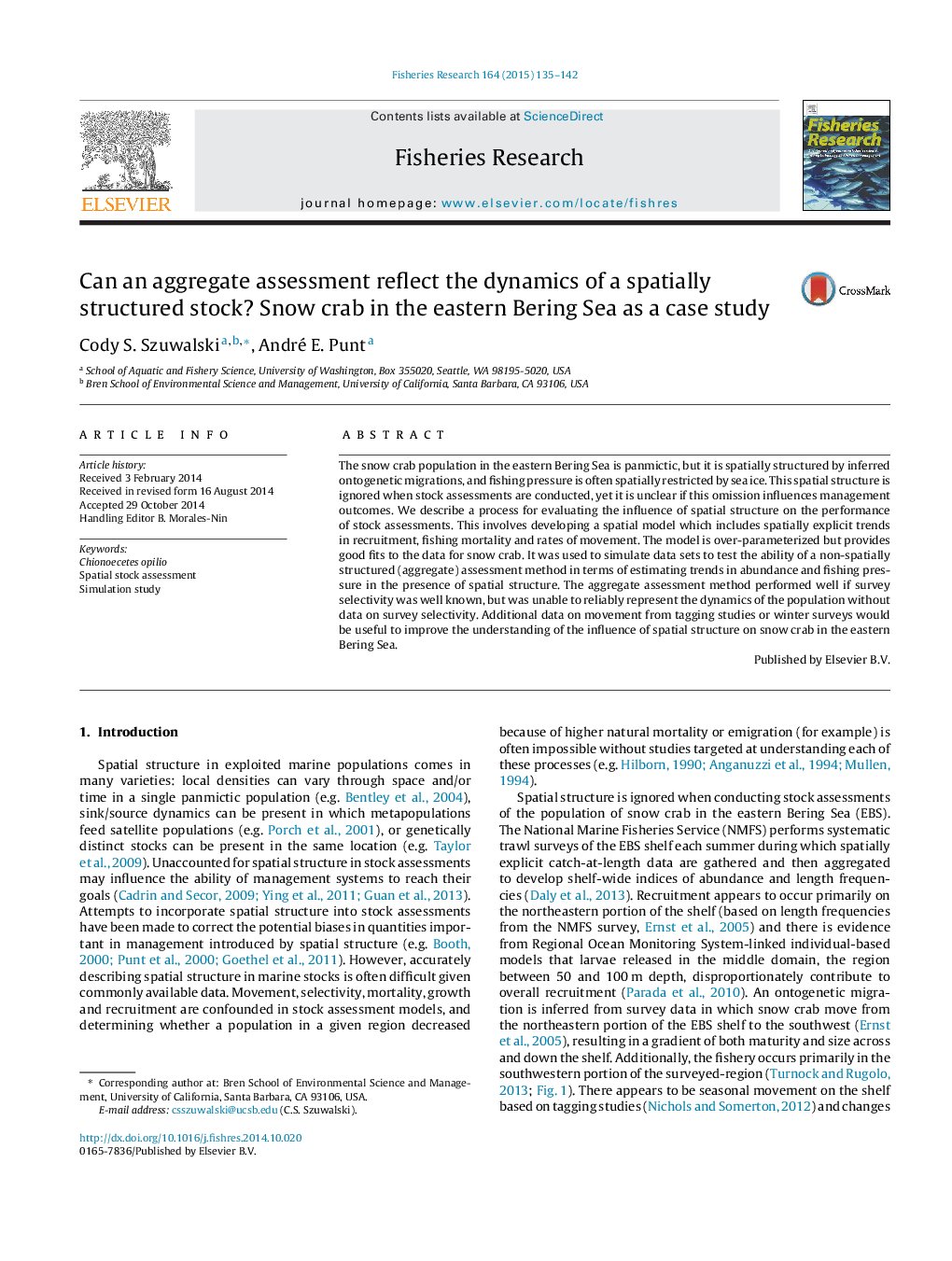| کد مقاله | کد نشریه | سال انتشار | مقاله انگلیسی | نسخه تمام متن |
|---|---|---|---|---|
| 6385680 | 1626804 | 2015 | 8 صفحه PDF | دانلود رایگان |
عنوان انگلیسی مقاله ISI
Can an aggregate assessment reflect the dynamics of a spatially structured stock? Snow crab in the eastern Bering Sea as a case study
ترجمه فارسی عنوان
آیا ارزیابی مجموعی منعکس کننده پویایی یک سهام فضایی است؟ خرچنگ برفی در شرق دریای بریج به عنوان نمونه موردی
دانلود مقاله + سفارش ترجمه
دانلود مقاله ISI انگلیسی
رایگان برای ایرانیان
ترجمه چکیده
جمعیت خرچنگ برف در دریای بریج شرقی دارای پامتیک است، اما به صورت مکتب فضایی با مهاجرت های انتوتوژنیک تعریف شده است و فشارهای ماهیگیری اغلب به صورت فضایی توسط یخ دریا محدود می شود. این ساختار فضایی هنگامی که ارزیابی سهام انجام می شود، نادیده گرفته می شود، با این حال مشخص نیست که آیا این بی عدالتی بر نتایج مدیریت تأثیر می گذارد. ما یک فرآیند برای ارزیابی تاثیر ساختار فضایی بر عملکرد ارزیابی سهام را توصیف می کنیم. این شامل ایجاد یک مدل فضایی است که شامل روند صریح صحیح در استخدام، مرگ و میر ماهیگیری و نرخ حرکت است. مدل بیش از حد پارامتر شده است، اما مناسب برای داده ها برای خرچنگ برف فراهم می کند. این برای شبیه سازی مجموعه داده ها برای تست توانایی یک روش ارزیابی غیر مرسوم سازه ای (جمع آوری) از نظر تخمین روند در فراوانی و فشار ماهیگیری در حضور ساختار فضایی استفاده شد. روش ارزیابی کلی نتایج خوبی به دست آمد، اگر به طور کامل شناخته شده بود، انتخاب روش بررسی شد، اما قادر به اعتماد به نفس نمیتواند نشان دهنده دینامیک جمعیت بدون داده های انتخابی انتخابی باشد. داده های اضافی در مورد حرکت از مطالعات برچسب زدن و یا مشاهدات زمستانی برای بهبود درک تاثیر ساختار فضایی بر خرچنگ برفی در دریای بریجینگ مفید خواهد بود.
موضوعات مرتبط
علوم زیستی و بیوفناوری
علوم کشاورزی و بیولوژیک
علوم آبزیان
چکیده انگلیسی
The snow crab population in the eastern Bering Sea is panmictic, but it is spatially structured by inferred ontogenetic migrations, and fishing pressure is often spatially restricted by sea ice. This spatial structure is ignored when stock assessments are conducted, yet it is unclear if this omission influences management outcomes. We describe a process for evaluating the influence of spatial structure on the performance of stock assessments. This involves developing a spatial model which includes spatially explicit trends in recruitment, fishing mortality and rates of movement. The model is over-parameterized but provides good fits to the data for snow crab. It was used to simulate data sets to test the ability of a non-spatially structured (aggregate) assessment method in terms of estimating trends in abundance and fishing pressure in the presence of spatial structure. The aggregate assessment method performed well if survey selectivity was well known, but was unable to reliably represent the dynamics of the population without data on survey selectivity. Additional data on movement from tagging studies or winter surveys would be useful to improve the understanding of the influence of spatial structure on snow crab in the eastern Bering Sea.
ناشر
Database: Elsevier - ScienceDirect (ساینس دایرکت)
Journal: Fisheries Research - Volume 164, April 2015, Pages 135-142
Journal: Fisheries Research - Volume 164, April 2015, Pages 135-142
نویسندگان
Cody S. Szuwalski, André E. Punt,
